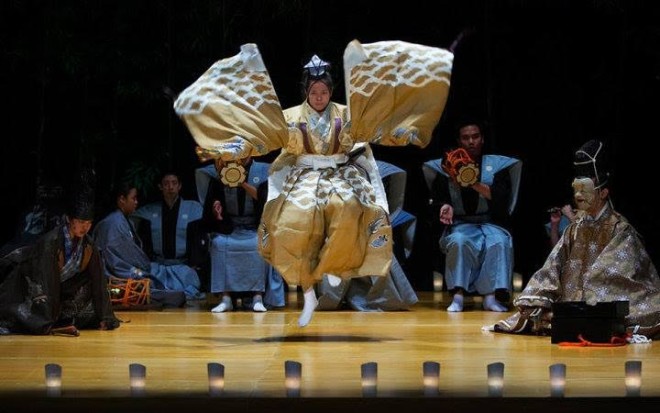
The Noh Theatre Ensemble (NTE), a resident theater group of University of the Philippines’ Center for International Studies (UPCIS), will stage “Cedula sa BGC: Isang Kontemporanyong Noh,” on Aug. 26-27 at University Theater, Villamor Hall, University of the Philippines.
“The Noh is set in a mall in BGC [Bonifacio Global City],” says NTE’s founding artistic director Jina Umali. “It’s about Andres Bonifacio, so meet the ‘B’ of BGC, the Father of the Philippine Revolution.”
NTE members have received continuous training since 2005 from Naohiko Umewaka, a Noh grand master whose family’s involvement in Noh dates back 600 years. Umali explains that centuries-old Noh is the oldest form among the Japanese performance traditions, characterized by the use of masks, controlled physical movements and abstracted choreography such as sliding steps, and lines that are sung.
“One of the differences between Noh and other art forms is that Noh deals more often with ghosts and the afterlife,” she says.
Adaptation
“I [wanted] to make Bonifacio return as a ghost through Noh,” says Umali.
“Cedula” is her adaptation of Ericson Acosta’s play “Moñumento,” staged in the mid-1990s by Alay Sining, into the Noh format.
What is a Filipino Noh, exactly?
“Most of the elements come from Noh theater, except the text [script and language] and the performers,” she says.
“‘Cedula sa BGC’ explores Bonifacio’s life and death, and his many roles such as thespian, nationalist, husband and leader of the revolution; it’s a distillation of the struggle and process to become Bonifacio and for the Philippines to become a nation.”
The production will be in Filipino with Filipino performers, in collaboration with Noh grand masters Umewaka (expert in Noh acting for principal roles), Shigeji Omura (expert in Noh drum) and Isso Yoji (expert in Noh flute).
“We train using the Noh repertoire and transpose the shodan, the structural segments of Noh, into Filipino.”
“The costumes of the major characters are real Noh costumes provided by the Noh grand masters. Some of the costumes are from the UPCIS collection of Japanese kimono and hakama (pleated trousers). Additional costumes are recreated by Darwin Desoacido,” she says.
Andrew Cruz plays Bonifacio. The cast also includes Diana Alferez, Tess Jamias, Derrick Gozos and Al Gatmaitan.
Otto Hernandez handles set and lighting design.
The production commemorates the 120th anniversary of the 1896 revolution led by Bonifacio against Spain, which began with revolutionaries tearing their cedula (community tax certificates).
The production also celebrates the 60th year of diplomatic relations between Japan and the Philippines and the 20th anniversary of the Japan Foundation in Manila.
Tailor-made
Umali points out that she isn’t directing the production in the Western sense of the word.
“The three Noh grand masters are my collaborators as there is no director in Noh. ‘Giving direction’ in this particular production means asking their opinion and involving them in the artistic decisions when it comes to their specializations.”
“We are in this together in the way that the Filipino performers and musicians are equally my collaborators. I present the concept and structure of the play to them, and the artistic details of the Noh tradition is interwoven into it—tailor-
made, so to speak.”
Umali has codirected “Kanjincho” with Tony Mabesa for Dulaang Unibersidad ng Pilipinas and has directed Amelia Lapeña-Bonifacio’s “Ang Paglalakbay ni Sisa: Isang Noh sa Laguna” for NTE.
She founded NTE to introduce Asian performance practices to Filipinos. Students who’ve joined the ensemble come from diverse backgrounds, with courses ranging from engineering to library science; no performing background is necessary.
The public is welcome to audition for future productions or to join the (usually free) training sessions. Schedules of upcoming sessions are announced on the group’s Facebook page.
“Cedula” is twin-billed with UPCIS Bunraku Ensemble’s staging of Andres Bonifacio’s “Pag-ibig sa Tinubuang Lupa,” featuring coloratura soprano Luz Morete, music by Restie Umali and choreography by Joanne Ko dela Calzada. (“Bunraku” is traditional Japanese puppet theater.)
Discounts are available for public high school and college students. “Cedula sa BGC” runs Aug. 26-27 at University Theater, Villamor Hall, University of the Philippines, Quezon City. Call 0918-9286398, 426-7573, 981-8500 loc. 2460 or [email protected]. Visit Bit.do/nohbunraku or Fb.com/PhilippineNohTheatre.













































